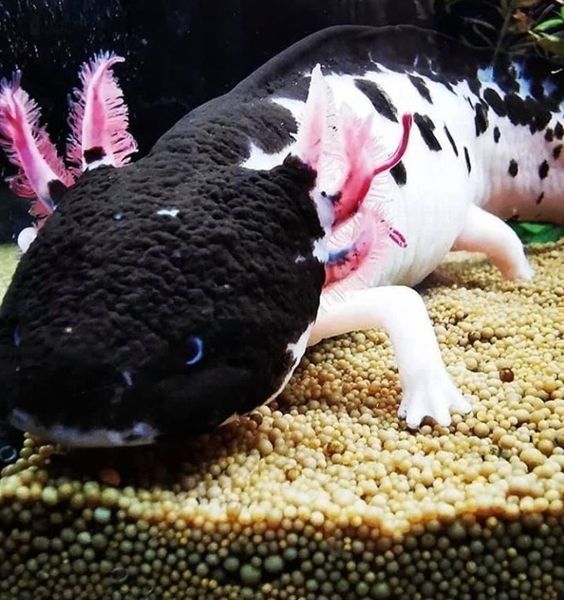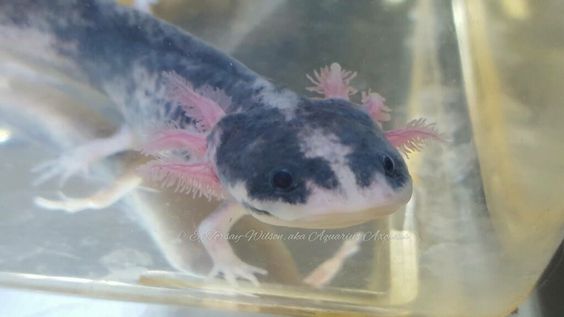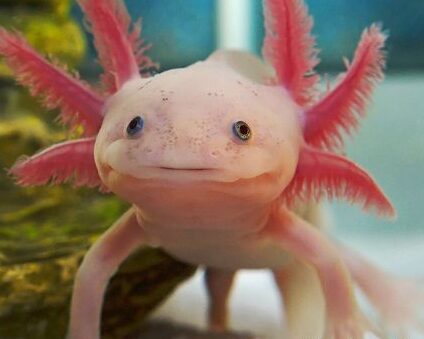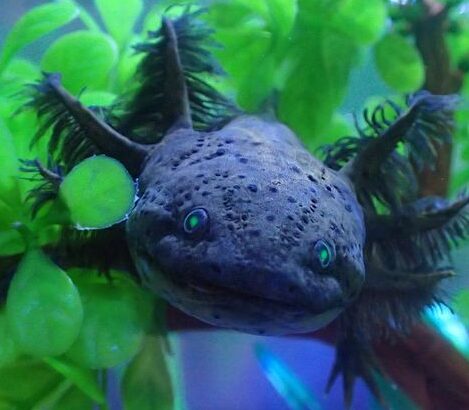
The piebald axolotl stands out as a truly unique aquatic creature, captivating enthusiasts with its mesmerizing patchy coloration. Unlike its more uniformly colored counterparts, the piebald axolotl boasts a distinctive mosaic of pigments, creating a visually striking appearance. This rare variant of the axolotl species has become a sought-after addition to aquariums, not only for its aesthetic appeal but also for the fascination it brings to the world of aquatic pets.
Piebald Axolotl Facts
Delving into the realm of piebald axolotl facts reveals a fascinating world of amphibian wonders. These creatures, with their intricate patterns, belong to the salamander family and are specifically known for their neotenic characteristics—they retain their aquatic larval features throughout their entire lives. Piebald axolotls exhibit a remarkable range of colors and patterns, from snowy white patches to dark pigmented spots, making each individual a living work of art.
What is a Piebald Axolotl?
A piebald axolotl, at its core, is a captivating variant of the axolotl species, known for its distinct piebald or patchy coloration. Unlike traditional axolotls, which typically exhibit a more uniform color, the piebald variety displays a mosaic of colors that can vary widely from one individual to another. This unique coloration is a result of genetic mutations that affect the distribution of pigments, creating a visually stunning and unpredictable array of patterns.
Physical Features
Exploring the physical features of the piebald axolotl unveils a creature that is not only visually enchanting but also biologically intriguing. These axolotls boast external gills, feathery appendages that set them apart from other aquatic species. Their streamlined bodies, adorned with piebald markings, make them a captivating centerpiece in aquariums. Understanding the nuances of their physical attributes enhances the appreciation for these remarkable aquatic beings.
Habitat in the Wild
In their natural habitat, piebald axolotls navigate the waters of lakes and canals in Mexico. These creatures are endemic to the Xochimilco region, where the lush aquatic environment provides an ideal home. The waters of Xochimilco offer a delicate balance of temperature and nutrient levels, creating a haven for axolotls to thrive. Preserving and mimicking these natural conditions is crucial for those seeking to provide a suitable home for these unique creatures in captivity.
Piebald Axolotl Habits
Understanding the habits of the piebald axolotl is key to creating a thriving environment in captivity. These aquatic creatures exhibit fascinating behaviors that reflect their natural instincts. Piebald axolotls are nocturnal by nature, preferring low-light conditions that mimic their native environment. Observing their nocturnal activities provides enthusiasts with a unique glimpse into their world, as they gracefully navigate their tanks in search of food or shelter.
Feeding Behavior
The feeding behavior of piebald axolotls is a captivating spectacle for aquarium enthusiasts. These creatures are carnivorous, with a diet consisting primarily of small worms, insects, and aquatic invertebrates. Their feeding style is deliberate and intriguing, as they use suction to draw prey into their mouths. Offering a varied and nutritionally balanced diet is crucial to promoting their health and ensuring they receive the essential nutrients for growth and vitality.
Tank Setup
Creating an ideal tank setup is essential for the well-being of piebald axolotls. These creatures thrive in spacious aquatic environments with cool temperatures ranging from 60°F to 68°F (15°C to 20°C). Providing ample hiding spots, such as plants and caves, allows them to exhibit their natural behaviors while also offering a sense of security. Proper filtration and regular water quality maintenance are critical to sustaining a healthy habitat that mirrors their native waters in Mexico.
Interaction with Other Axolotls
Understanding how piebald axolotls interact with others of their kind is crucial when considering a community tank setup. While they generally tolerate tank mates, caution is advised as axolotls can display territorial behavior, especially during feeding. Monitoring their interactions and ensuring adequate space and hiding spots can help prevent aggression. It’s important to note that keeping axolotls together requires careful observation and, in some cases, separating individuals to avoid stress or injury.
Piebald Axolotl Lifespan
The lifespan of a piebald axolotl unveils a journey marked by resilience and fascinating biological processes. These captivating creatures, when provided with optimal care, can live an average of 10 to 15 years in captivity. Unlike many amphibians that undergo metamorphosis, axolotls retain their aquatic larval features throughout their entire lives—a unique aspect contributing to their extended lifespan. Understanding the factors that influence their longevity enhances the joy of caring for these remarkable aquatic beings.
Average Lifespan
Averaging a decade and a half, the lifespan of piebald axolotls places them among the enduring denizens of aquariums. This extended lifespan is influenced by various factors, including water quality, diet, and overall environmental conditions. Properly maintained tanks, routine health checks, and a well-balanced diet contribute to their longevity. Witnessing a piebald axolotl traverse through the stages of life—from a tiny larva to a fully grown adult—is a rewarding experience that underscores the commitment required for their care.
Growth and Development
The growth and development of piebald axolotls are marvels of nature, showcasing a captivating transformation. From hatching as delicate larvae to developing into robust adults, axolotls undergo distinct stages of growth. Providing a suitable environment with proper nutrition is crucial for fostering healthy development. Enthusiasts have the privilege of witnessing the gradual evolution of these creatures, from their early stages to the full expression of their piebald coloration.
Health Considerations
Maintaining the health of piebald axolotls involves a holistic approach that combines proper nutrition, tank hygiene, and vigilance. These creatures are susceptible to certain health issues, including skin infections and metabolic disorders. Regular monitoring of their behavior, appearance, and water quality is essential for early detection and intervention. A proactive approach to health considerations, including consulting with a knowledgeable veterinarian, ensures a fulfilling and extended companionship with these unique aquatic creatures.
Piebald Axolotl Price
The allure of the piebald axolotl extends beyond its captivating appearance to considerations of cost. Understanding the pricing dynamics is essential for enthusiasts seeking to bring these unique creatures into their aquariums. The price of a piebald axolotl can vary widely based on several factors, making it an intriguing aspect of the journey into axolotl ownership.
Cost Factors
Exploring the cost factors associated with piebald axolotls unveils a multifaceted landscape. Rarity plays a significant role; the more uncommon the coloration pattern, the higher the potential cost. Size is another determinant, with larger and more mature specimens often commanding higher prices. Additionally, lineage and genetic factors contribute to the pricing, as certain bloodlines may produce more vibrant or unique piebald markings. Understanding these cost factors empowers enthusiasts to make informed decisions and appreciate the investment involved in acquiring a piebald axolotl.
Breeder Reputation
The reputation of the breeder becomes a pivotal consideration in the pursuit of a piebald axolotl. Reputable breeders prioritize ethical breeding practices, ensuring the health and well-being of the axolotls. Reviews, testimonials, and the breeder’s track record in producing quality specimens with desirable traits contribute to their reputation. Enthusiasts are encouraged to seek out breeders with a positive standing in the axolotl community, fostering trust and confidence in the source of their new aquatic companion.
Price Range
Navigating the price range for piebald axolotls provides enthusiasts with a spectrum of options. On average, these captivating creatures can be priced anywhere from $50 to $200, depending on the aforementioned factors. Understanding the price range aids in setting realistic expectations and allows enthusiasts to budget accordingly for not only the acquisition but also the ongoing care and maintenance of their piebald axolotl.
Piebald Axolotl Monthly Cost
Embarking on the journey of caring for a piebald axolotl involves not only the initial purchase cost but also ongoing monthly expenses. Understanding the monthly cost is crucial for enthusiasts to provide a thriving environment for their aquatic companion. This financial commitment encompasses various aspects, including diet, tank maintenance, and potential healthcare expenses.
| Expense Category | Estimated Monthly Cost (USD) |
|---|---|
| Diet and Feeding Expenses | $15 – $30 |
| Tank Maintenance | $20 – $40 |
| Healthcare Expenses | Variable (Emergency Basis) |
Diet and Feeding Expenses
The diet and feeding expenses of a piebald axolotl contribute significantly to the monthly cost. These carnivorous creatures have specific dietary requirements, feasting on small worms, insects, and aquatic invertebrates. Enthusiasts may need to invest in high-quality aquatic foods and live or frozen prey to ensure a well-rounded and nutritious diet. The monthly expense for their culinary needs is a testament to the commitment required to keep these captivating creatures healthy and vibrant.
Tank Maintenance
Maintaining the tank environment for a piebald axolotl is a critical aspect of their care and incurs monthly costs. This includes expenses for water testing kits, water conditioners, and regular filtration maintenance. Axolotls are sensitive to water quality, and a clean and well-maintained tank is essential for their overall well-being. The monthly cost for tank maintenance reflects the dedication needed to create a suitable and thriving habitat.
Healthcare Expenses
While piebald axolotls are generally hardy, unforeseen health issues may arise, necessitating healthcare expenses. Regular veterinary check-ups and potential treatments for conditions such as skin infections or metabolic disorders contribute to the monthly cost. Enthusiasts should be prepared for these potential healthcare expenses and consider them as part of the ongoing commitment to the well-being of their piebald axolotl.
Understanding and budgeting for the monthly costs associated with piebald axolotl care ensures a holistic approach to their well-being. It’s not merely a financial consideration but a testament to the dedication and responsibility that comes with providing a thriving environment for these captivating aquatic companions.
Piebald Axolotl For Sale

Embarking on the journey to acquire a piebald axolotl for sale opens up a world of possibilities for enthusiasts. These unique aquatic creatures are often available through various channels, including local breeders, online platforms, and specialty pet stores. However, ensuring a smooth and ethical acquisition involves considerations beyond the mere transaction, encompassing the reputation of sellers, shipping logistics, and legal compliance.
Finding Reputable Sellers
In the quest to bring a piebald axolotl into one’s aquarium, finding reputable sellers is paramount. Reputable sellers adhere to ethical breeding practices, prioritize the health and well-being of their axolotls, and have a positive track record within the axolotl community. Enthusiasts should seek out reviews, testimonials, and recommendations to gauge the credibility of sellers. Establishing a relationship with a reputable seller enhances the overall experience of acquiring and caring for a piebald axolotl.
Shipping and Handling
For those acquiring a piebald axolotl from a seller located at a distance, navigating the intricacies of shipping and handling becomes a crucial consideration. Shipping live aquatic creatures requires specialized packaging and adherence to temperature regulations to ensure the axolotl’s well-being during transit. Enthusiasts should communicate with sellers about their shipping protocols, including the use of insulated containers and expedited shipping methods to minimize stress on the axolotl.
Legal Considerations
Before finalizing the purchase of a piebald axolotl, enthusiasts must be aware of and adhere to legal considerations. Regulations regarding the ownership, sale, and transport of axolotls vary by region. Some areas may require permits or have restrictions on keeping axolotls as pets. Ensuring compliance with local laws is essential to avoid legal issues and to promote responsible ownership. Enthusiasts should conduct thorough research or consult with local authorities to understand and meet any legal requirements associated with acquiring a piebald axolotl.
FAQs
Q: Are piebald axolotls easy to care for?
A: Yes, piebald axolotls are generally easy to care for, but they require specific tank conditions and a proper diet.
Q: What is the lifespan of a piebald axolotl?
A: On average, piebald axolotls can live for 10 to 15 years with proper care.
Q: Can piebald axolotls change their color over time?
A: While axolotls can change color slightly, piebald markings typically remain consistent.
Q: How large do piebald axolotls grow?
A: Piebald axolotls can reach a length of 9 to 12 inches when fully grown.
Q: What do piebald axolotls eat?
A: They primarily feed on a diet of small worms, insects, and aquatic invertebrates.
Q: Can piebald axolotls be kept in a community tank?
A: It’s not recommended, as axolotls can be territorial and may exhibit cannibalistic behavior.
Q: How often should I clean the tank of a piebald axolotl?
A: Regular water changes and tank cleaning should be done every 2-3 weeks.
Q: Do piebald axolotls require a specific water temperature?
A: They prefer cooler temperatures between 60°F to 68°F (15°C to 20°C).
Q: Can I breed piebald axolotls at home?
A: Breeding axolotls requires specific conditions, and it’s recommended for experienced enthusiasts.
Q: Are piebald axolotls legal to own as pets?
A: Check local regulations, as legality can vary; in some places, a permit may be required.
Conclusion
In conclusion, the journey into the world of piebald axolotls is a captivating and rewarding endeavor, marked by the uniqueness of these aquatic creatures and the responsibilities that come with their care. From understanding their habits and lifespan to navigating the financial aspects of ownership, enthusiasts embark on a holistic experience that goes beyond the aesthetic appeal of these mesmerizing creatures.
The allure of the piebald axolotl extends beyond their patchy coloration to considerations of cost, involving factors like rarity, size, and breeder reputation. Embracing the monthly commitment includes dietary expenses, tank maintenance, and potential healthcare costs, reflecting the dedication required to provide a thriving environment. Moreover, the process of acquiring a piebald axolotl involves careful consideration of reputable sellers, navigating shipping logistics, and adhering to legal considerations specific to the enthusiast’s region.
With 3 years of devoted companionship alongside my aquatic friend, Bob, I’ve gained profound insights into the captivating world of fishkeeping. From understanding behavior to ensuring optimal health, my journey with Bob has enriched my expertise in all things aquatic.




Pingback: Chimera Axolotl: A Comprehensive Guide - Fish Hue
Pingback: Axolotl Care Guide - Fish Hue
Pingback: Axolotl Temperature: What's Best and How to Maintain - Fish Hue
Pingback: Do Axolotls Bite? Why and How to Prevent - Fish Hue
Pingback: Is Sand OK for Axolotls? Types, Benefits, and Considerations - Fish Hue